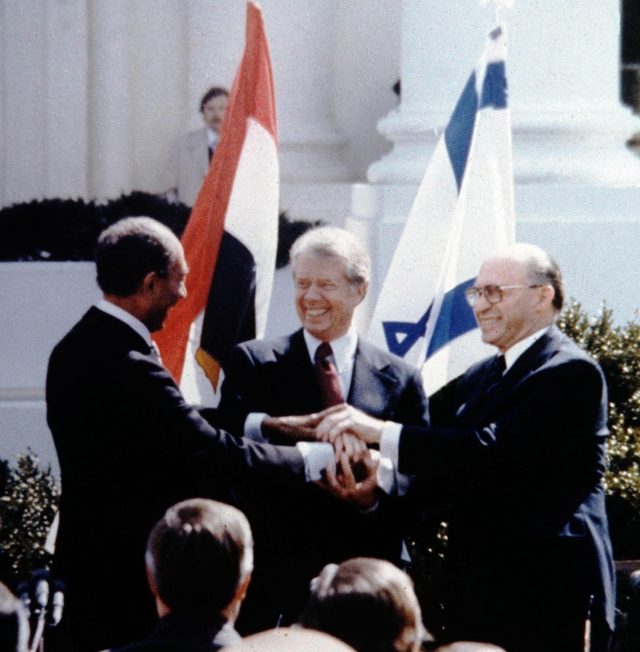A Timeline of the Israeli-Palestinian Conflict
Source: Churches for Middle East Peace (CMEP)
http://www.cmep.org/documents/Timeline.htm
Text in brackets has been added to the original CMEP timeline.
All photos on this page have been added by Palestine Portal
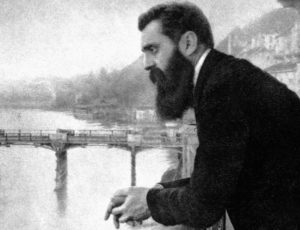 1896- 1897 Theodore Herzl (photo, right) publishes Der Judenstaat, “The Jewish State” calling for a Jewish state to solve the growing problem of anti-Semitism. First Zionist Congress discusses plans to establish a Jewish state in Palestine. Political Zionism begins.
1896- 1897 Theodore Herzl (photo, right) publishes Der Judenstaat, “The Jewish State” calling for a Jewish state to solve the growing problem of anti-Semitism. First Zionist Congress discusses plans to establish a Jewish state in Palestine. Political Zionism begins.
1914-1918 World War 1 – The Ottoman Empire, ruler of the Arab world since the 1500’s, is defeated.
1915 Hussein-McMahon Correspondence- Britain pledges support for Arab independence from Ottoman Empire [in return for military action against the Ottomans by Hussein’s forces, which he did provide]. Hussein and McMahon later disagreed over whether Palestine was included in the territory to be granted independence.
1916 Sykes-Picot Agreement – divides the Ottoman Arab lands into zones exercised by either French or British spheres of influence. Palestine comes under British influence
1917 Britain issues Balfour Declaration which calls for “support of the establishment in Palestine of a national home for the Jewish people…it being clearly understood that nothing shall be done which may prejudice the civil and religious rights of existing non-Jewish communities in Palestine.”
1922 Council of the League of Nations divides Arab lands; British mandate for Palestine is established.
1929 Arab-Jewish riots in Hebron and elsewhere left nearly 250 Arabs and Jews dead and the Jewish community of Hebron ceased to exist.
1933 Hitler’s rise to power in Germany. Jewish migration into Palestine increases.
1936-1939 The Arab Revolt – First major outbreak of Arab-Jewish hostilities. Revolt leads to the Peel Commission recommendation in 1937 of partitioning Palestine into Jewish and Arab states. Arabs rejected and Jews accepted but wanted more land. White Paper limits Jewish immigration; Jews found the Mossad to arrange for illegal immigration.
1939-1945 World War II – The Holocaust; Haj Amin El Husseini, Mufti of Jerusalem sides with Nazis. Jewish migration into Palestine intensifies (680,000 Jews in Palestine in 1946). By 1946, Lebanon, Syria and Jordan had attained independence.
1946 Hostilities in Palestine escalate, including the bombing of the British King David Hotel by the Jewish Irgun.
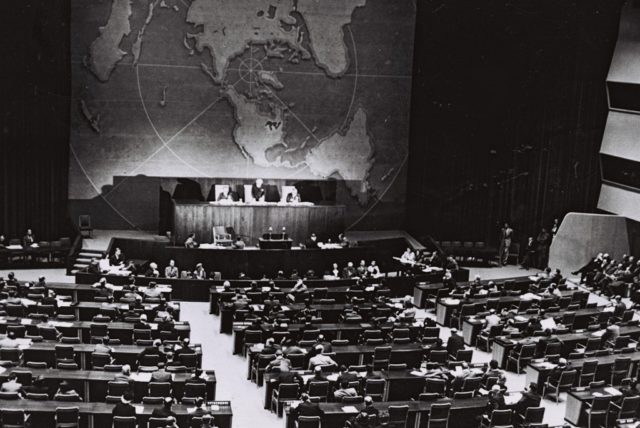 1947-1948 UN General Assembly Resolution 181 is passed (photo, right), partitioning Palestine into Jewish and Arab states. Greater Jerusalem was to be an international city (corpus separatum). UNGA Res. 181 rejected by Arabs. Tensions escalate. Deir Yassin Massacre (over 100 Palestinian civilians killed in Jerusalem village).
1947-1948 UN General Assembly Resolution 181 is passed (photo, right), partitioning Palestine into Jewish and Arab states. Greater Jerusalem was to be an international city (corpus separatum). UNGA Res. 181 rejected by Arabs. Tensions escalate. Deir Yassin Massacre (over 100 Palestinian civilians killed in Jerusalem village).
1948 British mandate ends; Israel declares statehood. Arab armies attack Israel. War results in a divided Jerusalem and 650,000 Palestinian refugees [most sources cite 700 to 750,000]. UNGA Res 194 establishes commission to facilitate the repatriation or compensation of refugees.
1949-1950 Armistice forms basis for what became known as the “Green Line.” Israel holds 77% of territory. Jordan annexes East Jerusalem and West Bank. Egypt controls Gaza Strip. UNRWA established. Jews from Arab countries begin migration into Israel. The Israeli Knesset passes the “Law of Return,” which entitles any Jew to full Israeli citizenship.
1956 Suez Crisis. Nasser’s nationalization of the canal leads to military action by France, Britain and Israel. US forces allies’ withdrawal. Eisenhower threatens economic sanctions on Israel if it failed to do so.
1964 Palestinian Liberation Organization (PLO) is established, with the stated aim of eliminating Zionism in Palestine.
1967 Six Day War – Israel launches a preemptive strike and conquers the Sinai, Golan Heights, Gaza Strip, the West Bank, and East Jerusalem, which it annexed. 600,000 Palestinians become refugees. UNSC Res 242 calls for Israeli withdrawal and establishes land for peace principle.
1969-1970 Israel begins establishing settlements in occupied territories. Jordan drives PLO out of Jordan: PLO forms base in southern Lebanon. Egypt’s “War of Attrition” against Israel, with Soviets aiding Nasser, leads to the Rogers Plan which sets UNSC Res. 242 as the basis for negotiations.
1973 Yom Kippur War – Egypt and Syria attack Israel. No territorial change. UNSC Res 338 calls for negotiations between the parties. Arab oil embargo begins and lasts for 5 months.
1974 Palestinian National Council adopts a political program. Israelis interpret this as staged liberation of Palestine; it comes to be viewed as meaning that a state in part of Palestine was acceptable to the PLO.
1977 Menachem Begin and Likud coalition win Israeli elections. Settlements in occupied territories increase. Egypt’s President Sadat goes to Israel’s Knesset and expresses desire for Egypt and Israel to live together in permanent peace based on justice? and calls for Palestinian right to own state.
1978 Camp David Accords (photo, right) – through negotiations led by President Carter, Sinai returned to Egypt in exchange for recognition of Israel; sets framework for settling Israeli-Palestinian conflict. Arab League expels Egypt. Israel invades Lebanon, occupies its southern border.
1980 Israeli government declares Jerusalem its eternal, undivided capital, affirming the de facto annexation of East Jerusalem, and its expanded municipal lines that included West Bank land.
1981 Israel annexes Golan Heights, captured from Syria in 1967.
1982 Israel invades Lebanon a second time and lays siege to Beirut. PLO moves its headquarters from Beirut to Tunis. Reagan Peace Initiative and Fez Summit Peace Proposal.
1987 First Intifada, a Palestinian popular uprising against the Israeli occupation of the territories, begins in Gaza and spreads to West Bank.
1988 The PLO accepts UN resolution 242 and 338, renounces violence and recognizes the right of Israel to exist within its pre-1967 borders. The United States opens dialogue with the PLO. Hamas, also known as the Islamic Resistance Movement is founded.
1991 Gulf War begins in January in response to Iraqi invasion of Kuwait in 1990. Madrid Conference – Israel and Arabs begin bilateral and multilateral negotiations.
1992 Bush-Baker Administration holds up $10 Billion in U.S. loan-guarantees to Israel (fiscal years 1993 to 1997) in attempt to limit Israeli settlement building. Israel expels 415 Palestinians suspected of pro-Islamist sympathies to South Lebanon.
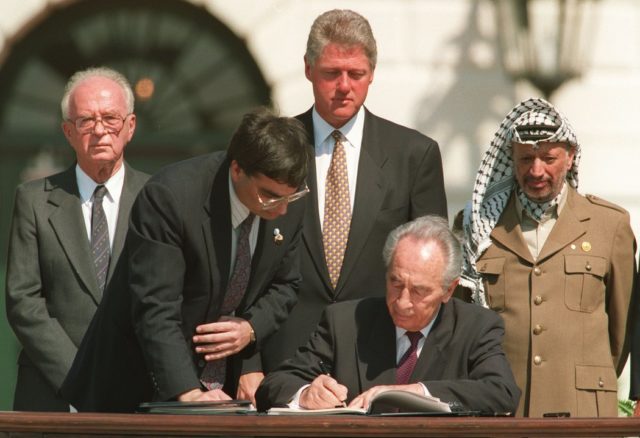 1993 Oslo Peace Process (photo, right), the agreement between the two sides to make gradual steps towards a final settlement of the conflict, begins. Clinton hosts PLO and Israel signing of the Declaration of Principles. Israel recognizes the PLO and gives it limited autonomy in the West Bank and Gaza, creating the Palestinian Authority. In return, the PLO gives up its claims to Israel’s territory as defined by its pre-1967 borders. First Hamas suicide attack.
1993 Oslo Peace Process (photo, right), the agreement between the two sides to make gradual steps towards a final settlement of the conflict, begins. Clinton hosts PLO and Israel signing of the Declaration of Principles. Israel recognizes the PLO and gives it limited autonomy in the West Bank and Gaza, creating the Palestinian Authority. In return, the PLO gives up its claims to Israel’s territory as defined by its pre-1967 borders. First Hamas suicide attack.
1994 Palestinian Authority is established in Gaza and Jericho. Arafat arrives in Gaza. Jordan & Israel sign peace treaty. Rabin, Peres, Arafat receive Nobel Peace Prize.
1995 “Oslo II” establishes 3 areas in West Bank: Area A— direct Palestinian control. Area B –jointly controlled: Palestinian civilian control and Israeli security control. Area C – exclusive Israeli control. Prime Minister Rabin is assassinated by right-wing Israeli fanatic in Tel Aviv.
1996 Palestinians elect Yasser Arafat as President. Israel launches “Operation Grapes of Wrath” in southern Lebanon; Netanyahu becomes Prime Minister of Israel. Summit in Washington between Arafat, Netanyahu, King Hussein, and Clinton.
1997 Hebron Protocol signed dividing city of Hebron. Israel starts building a settlement, Har Homa, on a hill overlooking East Jerusalem resulting in widespread protests. Peace process frozen.
1998 Wye River Memorandum, outlining further Israeli withdrawal from the West Bank, is signed but frozen. PNC renounces clauses in PLO charter that are offensive to Israel.
1999 PLO postpones declaration of statehood. Ehud Barak elected as Prime Minister, pledges to work for peace. Sharm el Sheik memorandum signed between Israel and PLO, final status talks begin. President Clinton attends PNC Meeting in Gaza.
2000 Camp David II – Clinton’s negotiations on final status issues between Barak and Arafat breakdown, largely over the issue of Jerusalem.
Sharon makes provocative visit to Temple Mount/Haram al-Sharif. Protesting Israeli-Arabs are shot by Israeli police. Second Intifada, a violent and sustained uprising, begins.
2001 Taba Talks: Arafat and Barak find common ground but no agreements. Bush inaugurated. Sharon elected Prime Minister. Violence escalates. Mitchell Report released. Ceasefire attempts are made but broken
2002 Reoccupation of Palestinian areas begins. Arafat placed under house arrest. Occupation of Church of the Nativity in Bethlehem.
2002 Saudi Crown Prince peace plan, endorsed by Arab League, promises recognition of Israel for ending occupation. UNSC Res. 1397 affirms 2-state vision, welcomes Saudi initiative and Quartet diplomacy. President Bush declares vision for a “viable Palestinian state next to a secure Israel.” Israel begins construction of “security fence” in the West Bank.
2003 US-initiated war in Iraq. Occupation of Iraq begins. The Road Map is released by the US, UN, Russia and the EU. Geneva Accords and People’s Voice Initiative released.
2004 Sharon announces unilateral Gaza withdrawal plan and gains U.S. support. Palestinian Authority President Yasser Arafat dies.
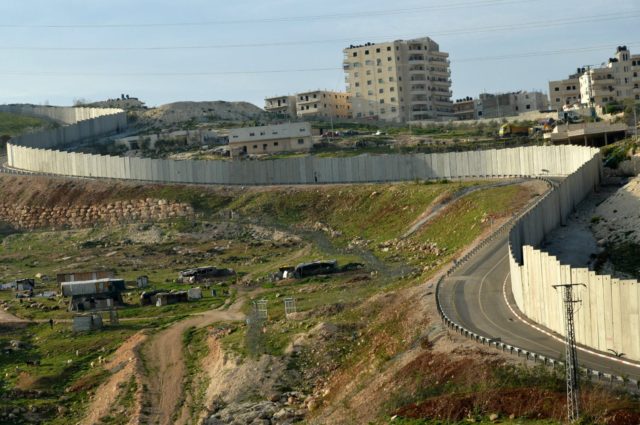 2004 International Court of Justice rules that the route of Israel’s “separation barrier” (photo, right) violates international law.
2004 International Court of Justice rules that the route of Israel’s “separation barrier” (photo, right) violates international law.
2005 Mahmoud Abbas elected President of the Palestinian Authority on a non-violent platform. Second Intifada ends with Sharm el-Sheikh summit in February and declaration of cease-fire by militant groups in March. In State of the Union address Bush recommits to two-state solution and asks Congress for additional aid to the Palestinians. Gaza withdrawal is completed in September.
2006 Prime Minister Sharon suffers a serious stroke; Deputy PM Ehud Olmert assumes power. Hamas, a State Department-designated foreign terrorist organization, wins majority in the Palestinian Legislative Council elections. Escalation of Israeli-Palestinian violence in Gaza and abduction of Israeli Corporal Gilad Shalit.
Hezbollah-Israel conflict erupts in the summer following kidnapping of Israeli soldiers; month-long war ends with a cease-fire on August 14.
2007 Mecca Agreement, brokered by Saudi Arabia, reached between Hamas and Fatah. Palestinian Unity Government formed in March. Arab League relaunches its Peace Proposal.
Hamas takeover of Gaza in June, leads to breakup of unity government and appointment of Salam Fayyad as new PM of PA.
Former British PM Tony Blair is appointed the Quartet’s Mid-east peace envoy and tasked with addressing economic and development issues in the territories.
President Bush announces Mid-east peace conference. The conference takes place in Annapolis without Hamas and with all Arab League nations participating including Syria and Saudi Arabia. Syria participates on the condition that a Syria-Israeli track will be pursued in the upcoming peace talks. Annapolis concludes with PM Olmert and President Abbas agreeing to a “joint understanding” to “make every effort to conclude an agreement before the end of 2008.”
 An international donors conference in Paris earns $7.4 billion for the PA.
An international donors conference in Paris earns $7.4 billion for the PA.
2008 In January, President Bush makes his first visit to the Holy Land as president. Also in January, Israel closes all border crossings with Gaza to halt Palestinian rocket attacks. Palestinian militants bomb the Rafah border and tens of thousands of Gazans cross the border into Egypt.
In May, Israelis celebrate Israel’s 60th anniversary and Palestinians reflect on the 60th anniversary of the “Nakba” (photo, right). Also in May, Israel publicizes that they are in negotiations with Syria via Turkish intermediaries.
In June, a Gaza cease-fire is brokered between Hamas and Israel by Egyptian intermediaries.
In September, Israeli PM Olmert announces intent to resign and by October Tzipi Livni announces she cannot form a coalition because of Shas party demands and calls for new elections.
In December, Hamas-Israel cease-fire expires and violence breaks out. Rocket fire from Gaza increases, and on Dec. 27 Israel launches Operation Cast Lead.
2009 Begins with escalating violence in Gaza and southern Israel. On Jan. 8 the UN Security Council passes Resolution 1860, calling for a full ceasefire. The U.S. abstains. On Jan. 17, Israel announces a unilateral end to offensive military operations in the Gaza Strip and on Jan.18 Hamas announces a one-week ceasefire, demanding Israeli troops withdraw from the Gaza Strip.
US President Barack Obama is sworn in on January 20. He and Secretary of State Hillary Clinton appoint former Senator George Mitchell as special envoy to the Middle East to work on the Israeli-Palestinian conflict.
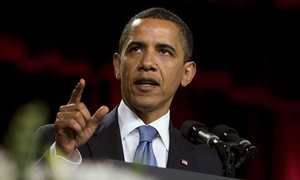 Israeli elections are held in February; Benjamin Netanyahu becomes Prime Minister with right-leaning coalition government in March. Obama Administration holds series of meetings and consultations throughout spring, including urging Israel to “stop settlement activity” and culminating in Presidential speech in Cairo on June 4 (photo, right).
Israeli elections are held in February; Benjamin Netanyahu becomes Prime Minister with right-leaning coalition government in March. Obama Administration holds series of meetings and consultations throughout spring, including urging Israel to “stop settlement activity” and culminating in Presidential speech in Cairo on June 4 (photo, right).
Adaptation by Churches for Middle East Peace from timeline prepared by Rev. Betty J. Bailey




